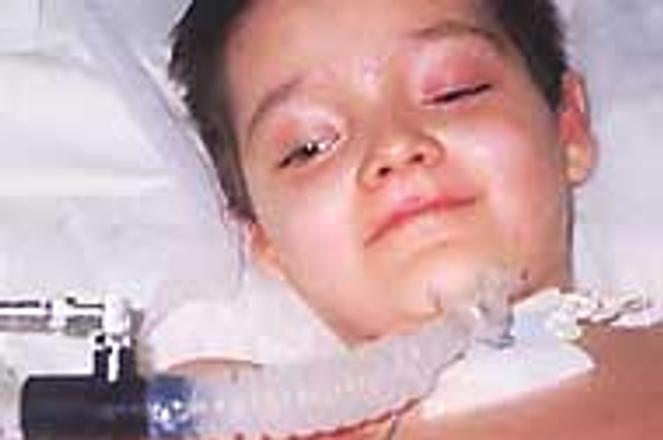EDKO, before the accident (above), and after.photo: Hischner Family
EDKO HIRSCHNER, 13, used to be a lively child. Every winter, when the lake in his village froze over, he would spend hours chasing a puck across the ice with his friends.
But his dreams of becoming a hockey player were destroyed one morning on his way to school. A car accident left the boy paralysed from his chin to his toes, and changed his life forever.
He spent four months in a coma and a total of three years in hospital before he could finally return home. He has recovered some vision from his initial blindness, but he still needs a special device to breathe, which makes it difficult for him to talk. He remains bedridden.
Edko's mother, Mária Hirschnerová, 47, remembers her son's injury as one does a nightmare, both vivid and at the same time unreal.
"It was horrible. When he woke up from the coma, he told me 'Mum, the only part of me that works is my brain.'
"The doctors said he wouldn't live, that he was suffering from a syndrome that usually kills people in a month. But my son was luckily an atypical case which went against the textbooks," she says.
His recuperation has also been one for the books - Slovak and foreign donors have stumped up over Sk1 million to cover the costs of a device that will finally let him leave his bed.
During the Davis Cup tournament in the east Slovak town of Prešov on September 22, Edko will be given a specially adapted wheelchair with artificial lungs.
The chair was far beyond the resources of Edko's parents in November 2000 when the boy returned from hospital. At Sk1,680,000 ($38,000), the wheelchair cost more than most Slovak houses, a daunting prospect for a family with four children and a slightly above-average income.
Mária Hirschnerová's first fundraising letter was addressed to Edko's insurance company, describing her son's handicap. The company turned them down, saying that Edko had not been home long enough to persuade them that he would live.
It was not until this year that the company gave the Hirschners Sk300,000 ($7,000) - more than they had been expecting, but only a fraction of what was needed.
But the family's desperate financial situation took a new turn when Peter Kurhajec from Konto Slovenska bez bariér (Slovakia Without Barriers, an NGO promoting better access for disabled people to public areas) replied to one of Mária Hirschnerová's letters.
"In the beginning there were no replies to my letters. It was like a dream when Mr Kurhajec called last May and said he would take care of it," she said.
One of the earliest donors was Ľubica Kurhajcová (18), a rising Bratislava tennis star and Kurhajec's niece. In September 2001, after winning a tennis match, Kurhajcová decided to give half of her Sk100,000 prize to Edko, after learning about his situation.
When Kurhajcová discovered that Edko loved hockey, and had been glued to the television during the Slovak men's hockey team's victory at the World Hockey Championships in May, she asked the gold medal winners to help. The team collected Sk100,000 ($2,300), while goalie Ján Lašák contributed another Sk50,000 after selling his hockey jerseys at a public auction.
"The lives of each one of us can easily turn out the way Edko's did, so I decided to help the family in their trouble. I keep in touch with him. I realised that there are some hard psychological fights in life," said Lašák.
Kurhajec's campaign to help the Hirschner family reached foreigners as well, with the Holland-Slovak Foundation contributing the largest sum of 5,000 euros.
According to the foundation's advisor, Juraj Puhala, "Edko was a special case."
The family has now managed to break the Sk1 million barrier, but still needs another Sk260,000 ($6,000) to pay off the wheelchair manufactures.


